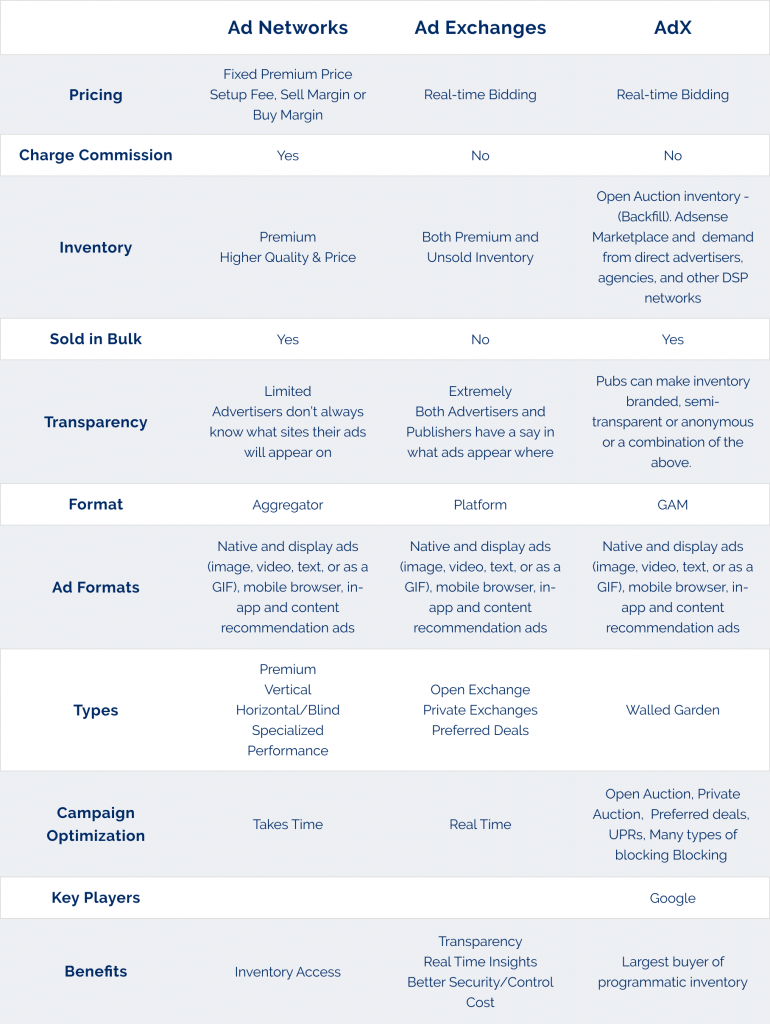
Publishers who monetize their content utilizing programmatic advertising often have many questions about the complex and constantly evolving field. One such question is whether to use header bidding or Google’s open bidding, which is now offered through Google AdX. Both options use ad networks and ad exchanges, but their effectiveness can vary greatly. Google AdX is similar to an exchange and makes it easy to get into programmatic advertising. However, it’s important to fully understand the terms before making a decision.
An ad network is a platform that connects advertisers with publishers to sell ad inventory in bulk. Networks typically work by aggregating ad inventory from multiple publishers and then reselling that inventory to advertisers by providing targeting options to help match ads to specific audiences. Ad networks can be a good option for advertisers looking to reach a broad audience across multiple websites.
An ad exchange is a digital marketplace where advertisers and publishers buy and sell ad inventory in real-time. Ad exchanges use real-time bidding (RTB) technology to match ads to specific users and inventory, allowing for more precise targeting and higher ad relevance. Ad exchanges are generally considered more efficient and effective than ad networks, as the inventory is sold at its true market value, and the ads are delivered to the most relevant audiences.
While both ad networks and ad exchanges can be useful for publishers, and the terminology is deceptively similar, their functions are very different. Choosing between them depends on each publisher’s specific needs and goals. Ad networks serve to sell ads in bulk and can be a good option for publishers looking to fill unsold inventory, whereas ad exchanges sell inventory dynamically and may be a better choice for publishers looking to maximize revenue. While the latter may seem like the better option at first glance, a healthy programmatic solution includes both.
The differences between networks and exchanges isn’t the only question on the minds of publishers stepping into RTB and programmatic advertising. There is also the question of whether it’s best to go with header bidding or to choose to go with Google’s open bidding. Both options make use of ad networks and ad exchanges to serve media, but their degrees of success can vary wildly from one another.
Google AdX is very much like an exchange, but is not entirely unlike a network, meaning that it lives in a middle ground. With AdX now offering open bidding to publishers, getting into programmatic advertising is promoted by Google as easier than ever. The easy option is rarely the better option, however, as we will further explain in this article.
Ad Networks vs. Ad Exchanges: The Programmatic Difference
Both ad networks and ad exchanges are integral parts of the programmatic advertising ecosystem. When dealing with ad networks, publishers connect directly to serve targeted ads based on the network’s bulk inventory, which is most often sold at a set price. The publisher also has no say in what ads are served when working with an ad network, meaning their audience may be shown ads that are not entirely appropriate for the content alongside which they are displayed.
Ad exchanges are the more dynamic of the two, as they feature real-time bidding (RTB) on their ad inventory. Real-time bidding is the core functionality of header bidding. The backend ad exchange handles the negotiation of pricing between partners, deciding within milliseconds which ad to serve based on which bid has the potential to create the highest yield for the publisher and the best performance for the advertiser. This is the more transparent and flexible of the two options, as publishers have a say in ad placement as well as the sorts of ads they are served.
A healthy programmatic ecosystem includes both ad networks and ad exchanges to serve premium ads from large advertising partners alongside more varied inventory from the exchange’s other publishers, also known as supply partners. Header bidding incorporates them both, as ad networks make portions of their inventory available on ad exchanges to be bid on. Direct selling of ad media on the part of ad networks is done in bulk, but that is not the case when their inventory is sold on an ad exchange.

A sophisticated programmatic ad management platform like PubWise can help navigate the differences between ad networks and ad exchanges. Its machine learning-powered header bidding platform connects publishers to premium demand partners as well as connections to dozens of quality demand sources through its publisher demand platform.
How does this relate to AdX? Enter Header Bidding vs. Open Bidding
The debate between header bidding and open bidding is less clear to smaller publishers, as both make use of real-time bidding ad exchanges. There are some distinct differences between the two that make header bidding the more appealing option for publishers who want to optimize their yield.
Open Bidding is Google’s answer to header bidding, allowing publishers to get into RTB without the same setup requirements. Google Open Bidding, also known as “Exchange Bidding” is a feature of Google’s ad exchange, Google AdX, that allows multiple demand-side platforms (DSPs) to bid on ad inventory in real-time. This allows publishers to access a wider range of demand sources and potentially increase the competition for their inventory, leading to higher ad revenues.
However, there are some known issues with Google Open Bidding that publishers should be aware of:
- Google’s Motive: It’s hard to avoid concerns that Open Bidding was developed merely to take oxygen out of Header Bidding. A recent US Antitrust Lawsuit directly makes that accusation.
- Complex setup: Implementing Google Open Bidding can be a complex process, requiring integration with a variety of different technologies and partners;
- Latency: The real-time bidding process can add latency to ad delivery, which can negatively impact the user experience;
- Limited control: Google Open Bidding can limit the publisher’s control over the ad delivery process, as they are relying on the DSPs to make decisions about which ads to show and when;
- Dependence on Google: Publishers may become too reliant on Google’s ad exchange, which could limit their options in the future; and
- Privacy concerns: Some users may have privacy concerns about the real-time tracking and targeting that is used in Google Open Bidding.
Overall, while Google Open Bidding can be a useful tool for publishers to access a wider range of demand sources and potentially increase revenue, they should also be aware of the potential issues and weigh the pros and cons prior to implementation.
For the publisher, there are two distinct aspects of open bidding to note. First is that auctions are done server-side rather than on the user end, which may result in slower load times for ads. The second is that because it resides exclusively within Google’s ecosystem, there are limited options to access new demand partners. The publisher can customize their preferred yield groups, but open bidding works with only ad exchanges and does not offer direct connections with ad networks.
The seemingly faster page load times offered by open bidding are a draw at first glance, but the lack of demand partner flexibility should be a deterrent for publishers interested in optimizing their yield. Header bidding allows publishers to pick and choose the demand partners they work with rather than relying on Google’s approved list, and often header bidding platforms allow for working with ad networks alongside exchanges.
In addition, obtaining access to the partners only available through Google Ad Exchange (AdX) on Google Manager requires a website build an audience of millions of pageviews per month before it can be placed into consideration. These premium demand partners are only available through Google AdX but are out of reach for most publishers through open bidding due to the size requirement. This is not necessarily the case with header bidding.
The primary advantages of Header Bidding vs. Open Bidding are:
- A Fair Auction: With an open, transparent, fair auction running on tech the publisher controls the goal is less opportunity for tipping of the scales by involved parties.
- Increased control: Header bidding gives publishers more control over the ad delivery process, as they are able to set their own parameters and make the final decision on which ad to display;
- Increased competition: Header bidding creates increased competition for ad inventory, as multiple demand sources are bidding simultaneously, rather than relying on a single exchange;
- Better pricing: Header bidding allows publishers to access the true market value for their inventory, as they can see the bids from multiple demand sources at once;
- Reduced latency: Header bidding can reduce latency, as the bids are made simultaneously, rather than in a sequential process;
- More transparent: Header bidding provides more transparency as the publisher can see all of the bids and can choose which ads are best for them, rather than relying on the DSPs to make the decision;
- Better Reporting: Open bidding through Google Ad Manager allows for basic reporting of analytic details such as traffic and billing, but does not give detailed data on served ads or partners; and
- Header bidding, particularly through a managed wrapper, allows instant analytics on partners, bid requests, CPM and participation rate.
Header bidding is not without its own set of challenges, such as adding complexity to the ad delivery process and creating additional latency. Additionally, some demand partners may not support header bidding, which can limit a publisher’s options.
While both header bidding and Google Open Bidding offer their own advantages and disadvantages, publishers may find that header bidding gives them more control, increased competition, better pricing, reduced latency and more transparency than Google Open Bidding. In addition, these options are not mutually exclusive. With a platform like PubWise you can run a header bidding stack, with AdX and Open Bidding and other options all at the same time.
Summary
In summary, programmatic advertising can be a complex field with many questions for publishers who are just starting out. One important consideration is the choice between ad networks and ad exchanges. Ad networks sell ad inventory in bulk, while ad exchanges use real-time bidding to match ads to specific users and inventory, allowing for more precise targeting and higher ad relevance. Both can be useful, but the choice will depend on the publisher’s specific needs and goals. For example, if a publisher has unsold inventory, ad networks can be a good option for filling that inventory, while ad exchanges can be a better choice for maximizing revenue from the inventory.
Another important consideration is the choice, but more often the balance since you can run both, between header bidding and Google’s Open Bidding. Header bidding is a technique that allows publishers to offer their inventory to multiple demand sources simultaneously, including ad networks, DSPs and ad exchanges, before making a final decision about which ad to display. This allows publishers to access a wider range of demand sources and increase competition for their inventory, potentially leading to higher ad revenue.
Despite the benefits of header bidding, it can also have its own set of challenges, such as adding complexity to the ad delivery process and creating additional latency if misconfigured. Additionally, some demand partners may not support header bidding, which can limit a publisher’s options.
Platforms like PubWise can help publishers set up their header bidding implementation. PubWise is a header bidding platform that simplifies the process by providing a unified header bidding Header-as-a-Service solution for publishers that also runs alongside AdX and Open Bidding. PubWise helps with the setup, administration and optimization of all of these ad stack technologies and allows publishers to easily add multiple demand partners, manage the bids and ad delivery and optimize revenue. PubWise also provides detailed analytics and reporting, so publishers can track the performance of their header bidding setup and make data-driven decisions. With the help of PubWise, publishers can take advantage of the benefits of header bidding without the added complexity and challenges.
In conclusion, programmatic advertising can be complex and for publishers, especially those who are new to the field. Both ad networks and ad exchanges, as well as header bidding and Google’s Open Bidding, have their own advantages and disadvantages. It’s important for publishers to understand the terms and weigh the pros and cons before making a decision about with whom to partner with. Platforms like PubWise can help simplify the process of setting up header bidding and provide a unified solution for publishers.





